Individual Extension Plan (IEP) Process and Program Planning Expectations
Video Length: 1:51:31 | Date:
Speaker: Dr. Jeff Howard
University of Maryland Extension 2024 Program Planning Guide
A downloadable version of this Guide and access the to Watermark can be found at the bottom of this page.
State Program Leaders
| Ms. Sandy Corridon, 4H Youth Development | corridon@umd.edu | |
| Dr. Bill Hubbard, ENRSG | (301) 789-9441 | whubbard@umd.edu |
| Dr. Darren Jarboe, AgFS | (301) 789-9441 | jarboe@umd.edu |
| Dr. Patsy Ezell, FCS | pezell@umd.edu |
For Operational and Evaluation Guidance
| Ms. Dee Dee Allen | 301-432-4490 | dallen3@umd.edu |
INTRODUCTION
The 2024 program planning year finds UME nearing the end of a five-year planning cycle (2020- 2024). Each year, all UME faculty, along with campus-based faculty with Extension appointments are required to participate in the UME program development and planning, evaluation, and reporting process. This is a federal requirement.
Annual Individual Extension Plans (IEPs) are based on the four UME program areas as identified in the 2020-2024 UME Strategic Programmatic Plan developed by the organization.
- Agriculture & Food Systems: The University of Maryland Agriculture and Food Systems (AgFS) Extension Program serves the leading private industry in the state. In 2017, the market value of Maryland crops and livestock sold exceeded $2.4 billion and contributed $8.25 billion to the Maryland economy. The AgFS Team conducts applied research and provides educational programs for production and marketing of grains, oilseeds, horticulture, floriculture, poultry, dairy and beef cattle, sheep and goats, equine, and other livestock, helping producers adopt new technologies and practices to improve profitability. As an example, Maryland agriculture has worked to conserve resources and improve water quality through new management practices such as cover crops and nutrient management planning.
- Environment, Natural Resources and Sea Grant: The University of Maryland Environment, Natural Resources and Sea Grant (ENRSG) Extension Program helps sustain Maryland’s rich environment, including its diverse habitat and abundant natural resources. From coastal beaches to the Chesapeake Bay to forested mountains, our rural, wildland, and urban ecosystems are of immeasurable value to our residents and require diligent stewardship to maintain their richness. ENRSG works to inform and equip individuals and communities to implement research-based conservational use, protection and, where appropriate, preservation of natural resources. This program area focuses on aquaculture, seafood safety, energy, coastal climate change and resiliency, forest and wildlife management, homeowner horticulture and gardening, water and watershed management, green infrastructure and sustainable living, and environmental and natural resources literacy.
- Family & Consumer Sciences: The University of Maryland Family & Consumer Sciences Extension Program (FCS) strives to ensure that all Maryland residents are healthy and economically successful at every stage of life through education, research, and outreach programs. We accomplish this by working with youth and families to prevent and manage chronic diseases through healthy food and physical activity choices, handling food safely, having financial literacy, health insurance literacy, and safe and healthy places to live, work, play, and learn. We help people acquire knowledge, skills, and confidence necessary to make informed decisions that affect their health and economic well-being. We help them identify health risks and then make a plan to reduce those risks. We help people make choices that reduce debt, increase savings for emergencies and long-term goals, and make spending plans based on how much they earn and what their expenses are. We work with adults, young people, schools, organizations, businesses, and communities. We develop partnerships to maximize our expertise and outreach. Our work is based on the latest research from the University of Maryland and other institutions is aimed to influence policy, systems, and environmental changes.
- 4-H Youth Development: Maryland 4-H is the youth development program of the land grant and Extension system. More than 51,000 youth, and 3,000 volunteers engage in Maryland 4-H annually. 4-H youth learn life skills through community focused, research-based experiential education programs. High quality science, civic engagement, and healthy living programs are delivered through clubs, afterschool and school programs, camps, fairs and other community partners. Youth development professionals and volunteers support youth thriving through nurturing sparks, promoting high quality experiences, and cultivating positive relationships within communities.
Faculty are to plan 70 to 80% of their programming in alignment with UME’s priority programming areas as outlined in the strategic plan.
PROGRAM PLANNING CALENDAR
2023 |
|
| October 13 |
|
| October 27 |
|
| November 1–13 |
|
| November 14 |
|
| December 1 |
|
| December 4 |
|
| December 15 |
|
2024 |
|
| January 16 |
|
PURPOSES FOR PLANNING AND REPORTING
Sound planning and reporting identifies how Extension programs are directed and what accomplishments and impacts have occurred as a result of these efforts.
Detailed planning and reporting can help maximize limited human and fiscal resources allocated to the development, delivery, and evaluation of Extension educational and teaching efforts.
Impacts and successes of UME programs are necessary as we communicate with the general public and public officials on important budgetary issues discussed in the U.S. Congress, the Maryland General Assembly, and by county/city councils and commissions.
Accountability and program impact information is also shared with our Extension partners across the state and country.
UME receives funds from federal and state appropriations for which there is accountability for both the fiscal expenditures and for what has been achieved with the resources. UME is required to provide an accountability system that documents program outcomes achieved on an annual basis.
Systematic planning and reporting are required of all UME Faculty to meet Federal program guidelines including, but not limited to the Smith-Lever Act, the Agricultural Research, Extension and Education Reform Act of 1998 (AREERA), and the Government Performance and Results Act of 1993 (GPRA). This includes Extension specialists on and off campus. Anyone with an Extension appointment is required to follow established planning and reporting guidelines.
A Program Planning site has been established for your use which has all the resources needed for completion of the IEP at: UME Answers - Program Planning Central
At this site, you will find the:
- Guide to 2024 UME Program Planning documents
- Links to IEP Instructional Videos
- Power Points from Training Sessions
| Please note that the IEP process is iterative and adjustments can be made during the year for new responsibilities as they arise. It is your responsibility as a faculty member to notify your Program Leader of program changes. For minor changes, an email will suffice for changes in program focus/emphasis. |
PROGRAM DEVELOPMENT & EVALUATION TERMS & DEFINITIONS
To provide a common understanding of terms for this programming cycle, the following definitions are provided:
- UME faculty are all tenured/tenure-track (TTK)/professional track (PTK) faculty members in academic departments, special units, or field offices plus all Extension associate agents with specific educational program duties on federal, state, county, or grant funds.
- Programmatic Plan is the overall strategic direction of UME for 2020-2024.
- Major programs are a comprehensive set of activities that includes an educational component that is intended to bring about a sequence of outcomes among targeted clients.
- Program Area Outcomes are UME group responses to specific programming needs and will be used to guide group actions toward meeting specifically identified needs across location and discipline. Individuals should participate in one or more Program Area and respective Action Teams.
- Individual Extension Plan (IEP) is the individual’s response to the UME Programmatic Plan which will be used to guide the individual’s programming efforts during the year. It will serve as your roadmap for programming throughout 2023 and should provide a detailed timeline of your planned work in the Outputs section.
- Program inputs are the resources, contributions, and investments that you need to develop and implement a program. There are many typical inputs that go into Extension programs, such as time, expertise, and funding.
- Program outputs are activities, services, events, and products that you will produce for your program. For example, workshops and classes are outputs.
- Programs outcomes and impacts are the results your program will achieve for individuals, groups, organizations, and communities.
- Short term outcomes: New knowledge, aspirations, skills, attitudes (KASAs), Awareness, Opinions, and Motivations
- Medium term outcomes: Action, Behavior, Practice, Decision-making, Policies, and Social Action
- Long term outcomes: Conditions, Social, Economic, Civic, and Environmental Program indicators/measures are what give us the evidence that our program outcomes have been obtained.
- Clusters are the eight geographically-defined areas that UME uses for both programmatic and administrative purposes. In the “Inputs” section of the IEP, Educators are expected to provide details of program work to facilitate and leverage programming efforts within their clusters. The map of Maryland with UME clusters is below.
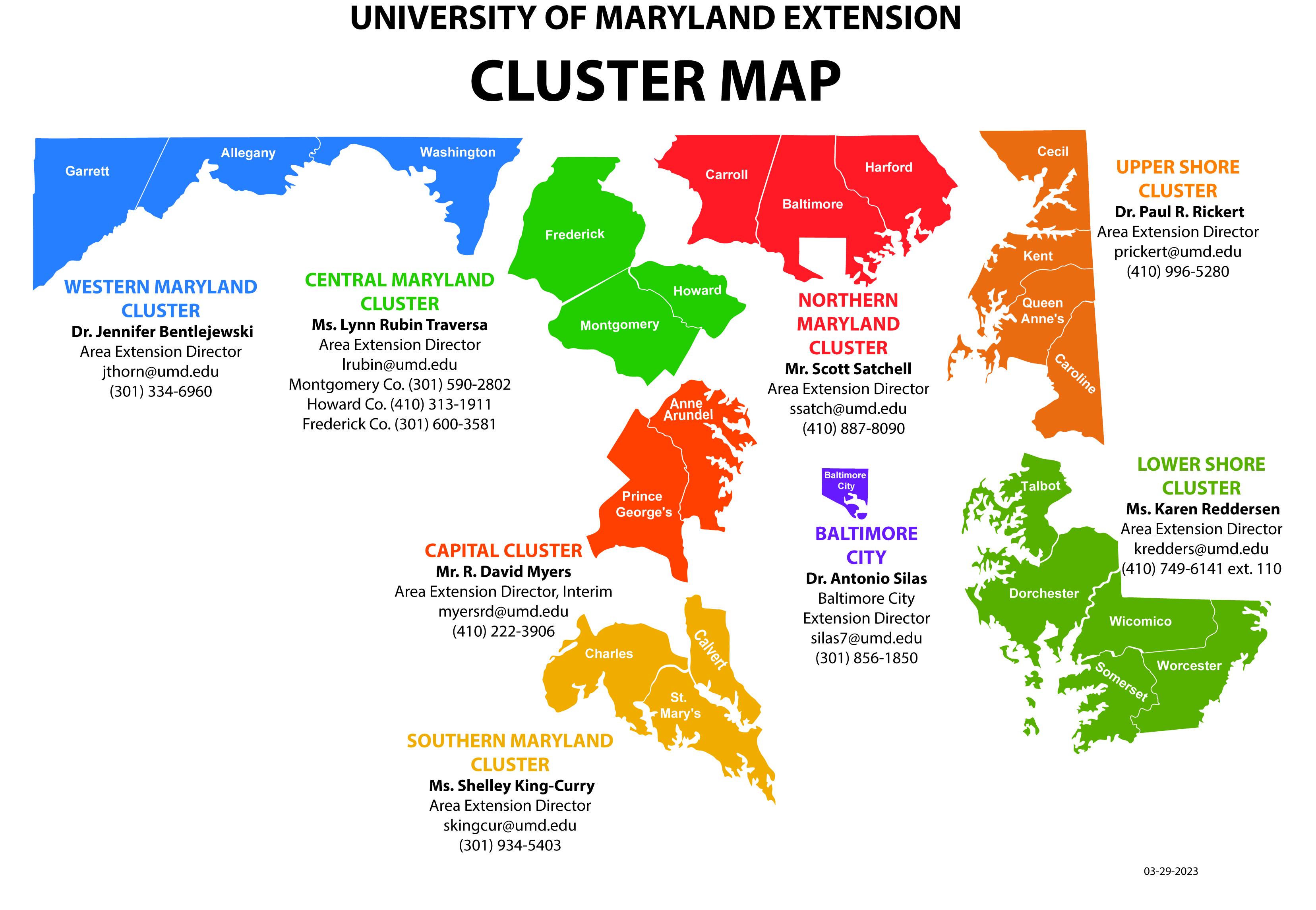
HOW TO DEVELOP YOUR IEP
The IEP form has been created in the same software platform as UMERS and your annual Faculty Activity Report – Watermark Faculty Success.
You may access IEPs by logging into this web address:
https://www.digitalmeasures.com/login/umd/faculty
Use your University ID (UID) and Password to log into the system. The IEPs can be found on the “Activities” tab in the section “University of Maryland Extension Program Planning.” There are separate IEPs for Agriculture and Food Systems, Environment and Natural Resources, Family and Consumer
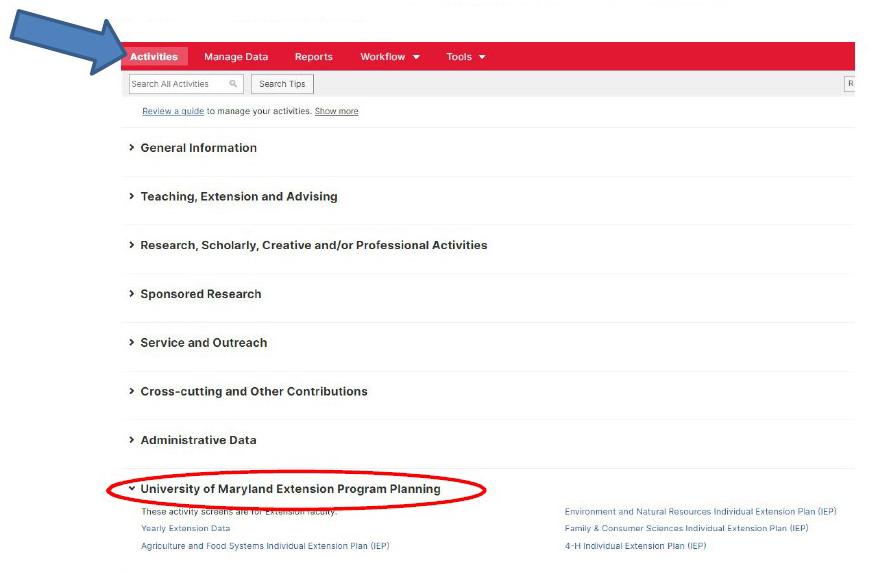
The IEP form has been customized across the four UME program areas to allow for a tailored approach to communicate your program plans to the program leaders.
Instructional videos have been created for users that offer detailed instructions.
A program development and evaluation (PDE) workshop is offered for those new to the IEP process.
A “how-to-write” impact statements workshop is offered to help with the program reporting process.
Basic IEP Format
The UME IEP is based on the logic model format. To learn about the basic components of a logic model, please go to the supporting documentation in the Appendix.
All IEPs have the same basic format, but numbered sections (such as Section II, Section III, etc.) vary across the four program areas. Therefore, the sections are discussed by title and not the particular section number as seen in the IEP.
It is important that you carefully read instructions and contact your Program Leader for any program area specific instructional videos.
GETTING STARTED
The first step is to choose the correct IEP for your Program Area. After selecting the IEP, you will be greeted by this screen. Choose “Add New”.

FIVE-YEAR PLANNED STATEMENT OF WORK
Be sure to type in the current planning year in this box.

All faculty must write a five-year (2020-2024) planned statement of work. This is a broad overview of your planned work and should be a maximum of 250 words.
In this section, Agriculture and Food Systems (AgFS) and Environmental and Natural Resources (ENRSG) faculty must estimate the percentage of program time they plan to allocate to support each of the five AGNR strategic initiatives. The total percentage of time across all initiatives should not exceed 100. It is expected that AgFS Educators would have 100% of their work assigned to these initiatives. The screen might look like this:
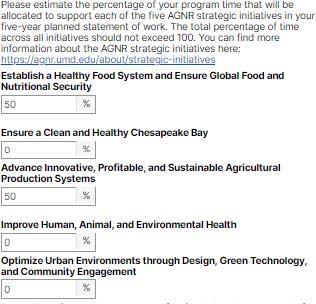
However, that may not be the case for ENR faculty. An example is: faculty member X plans to devote 50% of time to ensuring a clean and healthy Chesapeake Bay but the rest of their programmatic work does not fit within any of the other strategic initiatives. You would enter 50 into the “Ensure a Clean and Healthy Chesapeake Bay” and 0 in all of the other boxes.
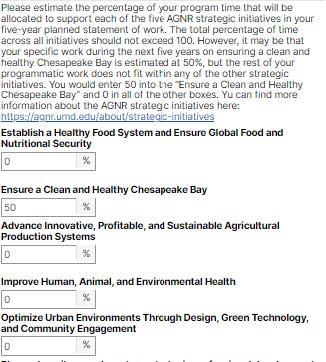
You can find more information about the AGNR strategic initiatives https://agnr.umd.edu/about/strategic-initiatives
Family & Consumer Sciences (FCS) faculty must enter the percentage of time estimated for priority
program areas.
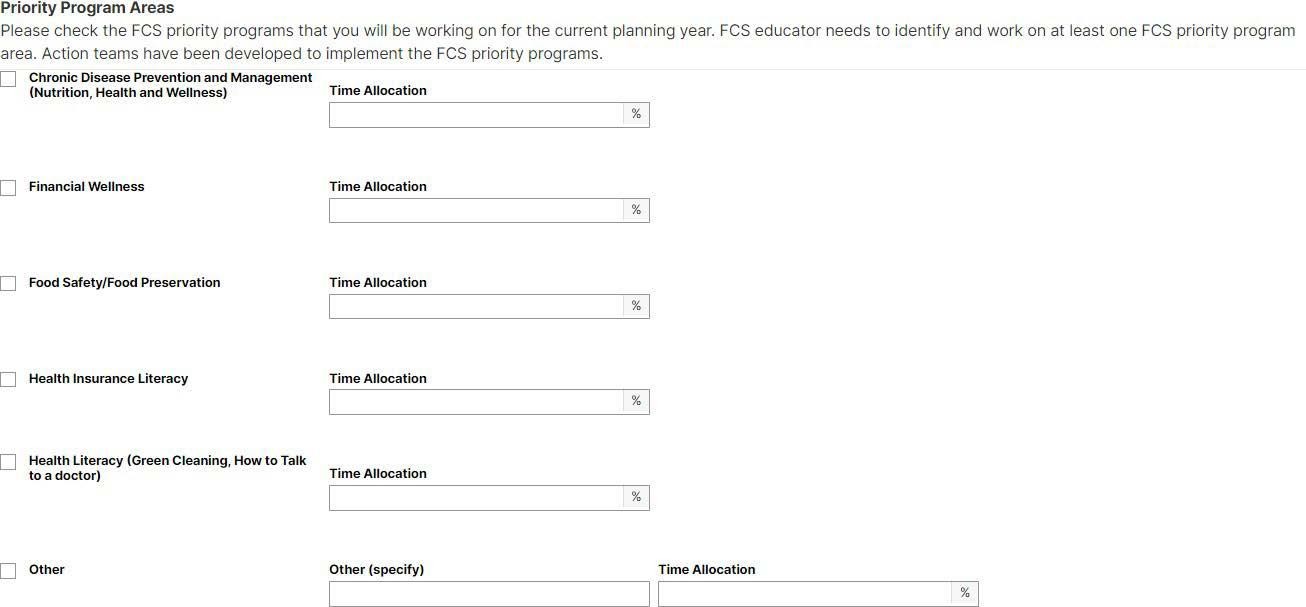
FCS faculty should pay attention to the item, “Partnerships Building and Maintenance”. This item was added as a direct result of the strategic listening sessions with community partners and Statewide Extension Advisory Council members. You should address strategies to maintain local and statewide partnerships that enhance your Extension programming efforts.

4-H faculty must enter the target enrollment numbers as follows:

4-H Educators should pay attention to the item, “Diversity, Inclusion, and Equity” in Section II. This item was added as a direct result of the strategic listening sessions with community partners and Statewide Extension Advisory Council members. You should briefly describe the youth and adult demographics in your county/city. You should also add your target enrollment numbers for 2020-2024.
MAJOR PROGRAMS OR PRIORITY AREAS
All program areas require faculty to enter plans (inputs, outputs, outcomes, measures) for each major program that they will work on in 2023. Major programs are a comprehensive set of activities/events which are designed to produce short-, medium-, or long-term outcomes/impacts and that will be measured through a formal evaluation process. Major programs evaluate short- and medium-term changes in knowledge, attitudes, skills, and aspirations (KASA) and/or behavior change. Long-term changes (impacts) are those which occur in social, economic, and environmental conditions (SEEC). New faculty within their first year of work may have one major program; faculty with several years of experience may have three to four major programs.
This material is taken from a fact sheet developed by University of Florida-Institute of Food and Agriculture entitled “What is an Extension Program?” written by Israel, Harder, & Brodeur (2015). Addendum 2.
Concept of a Major Program
Major programs are those that require a substantial investment of resources (e.g., expertise, time, money) to conduct, that have the potential for substantial impact, and that reflect a comprehensive set of educational activities (Summerhill, 1994). The main idea behind a major program is that a bigger, more focused effort will lead to large-scale, significant impacts. As a rule of thumb, a major program involves a minimum of 40 days of planned time during each year of a multi-year program. Major programs often involve collaboration with county faculty members who have similar programs in other counties or with those in the same county who have complementary subject-matter expertise. Major programs also are likely to have strong linkages with state-level teams, which provide support with educational resources and related expertise.
The development of major programs by Extension faculty is consistent with expectations of clients and external stakeholders. That is, people expect Extension to do big things, and major programs are the mechanism for creating significant change. In addition, each faculty member is expected to develop one or more major programs and report on their outcomes in annual reports of accomplishment. More importantly, being able to document the scope and impact of major programs is critical for achieving permanent status (or tenure) and promotion at the university. To read this in entirety, see Addendum 2: “What is an Extension Program?”
In this section, 4-H, ENRSG, and FCS Educators must (if applicable) link their major program to at least one and no more than three of the five AGNR strategic initiatives. If you are uncertain as to if a major programs fits into one of the five initiatives, you can indicate so by checking the box with this statement:

4-H faculty should also indicate which of the 4-H youth-related priority area(s) that the major program will address and provide a youth priority needs situation statement about the major program.
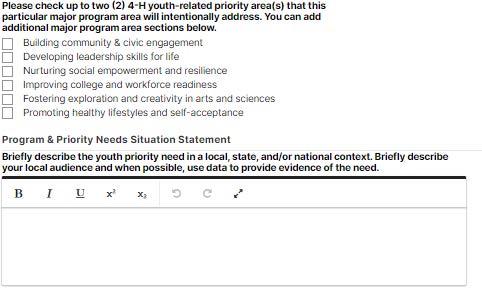
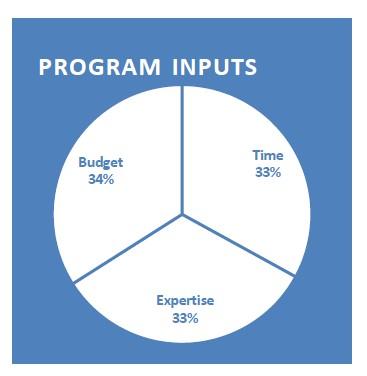
Program Inputs
Inputs are the resources, contributions, and investments that you need to develop and implement a program. There are many typical inputs that go into Extension programs (time, expertise, budgets). For example, an important or critical input to your program may be a particular type of funding. Or, you may need to partner with another organization to achieve your program plan.
In this section, give a brief description of the most important or critical inputs for your program work. Types of inputs expected for each of the four program areas include:
| 4-H | AgFS | ENRSG | FCS |
|---|---|---|---|
|
|
|
|
Program Outputs
Outputs are activities, services, events, and products that you will produce for your programs. For
example, workshops and classes are outputs.
All faculty are being asked to provide target numbers for specific categories. For example, FCS faculty
are asked to provide an estimate for the number of classes that will be taught and for the total number of
class participants (among others). 4-H faculty are asked to estimate enrollment numbers.
This is an example of the AgFS estimates for outputs:
AgFS and ENRSG Educators must indicate and describe outputs within the categories of:
- Research, scholarly, creative, and professional activities
- Teaching, extension, mentoring, and advising activities
- Service and outreach activities
- Other
FCS and 4-H faculty must provide a quarterly description of the program outputs. For example, if you plan to teach workshops, give the name of the workshop, the number of workshops you will teach, and the targeted audience. If you plan to present at a conference, give the name of the conference and the title or topic of the presentation. If you plan to write a journal article or Extension publication, give the draft title and the Journal that you plan to submit to.
Outputs will be updated by all Educators on an annual basis in the five-year planning cycle.
Program Outcomes
Outcomes are the results your program will achieve for individuals, groups, organizations, and communities. New knowledge, aspirations, skills or attitudes (KASA’s for short-term), behavior changes (medium-term), and impact (long-term) are common outcomes of Extension programming. The implementation of a best management practice is an example of an outcome. Impacts are the actual social, economic, or environmental changes (SEEC) resulting from the outcomes achieved. Examples of impacts can be the specific dollar value of cost savings of implementing a best management practice or the nutrient or sediment reduction observed by implementation of a best management practice. Outcomes differ across the four program areas. Remember, when choosing an outcome you should plan to identify the measure that will be used to document that outcome.
Outcomes for 4-H are articulated in logic models. The logic models are in a Box folder available at https://umd.box.com/s/24xdxo3a7yt1hcmnmfbwpyz5c84chqy3.
You will need to choose the logic model(s) you will use that are listed within the scroll box
Outcomes for FCS are also contained in logic< models developed by action teams. You can access these files in Google Docs (shared folder, “Family & Consumer Sciences”). For each major program, list the curriculum or program and the following information:
For AgFS, the outcomes to associate with a major program include:
- Increased profitability
- Improved production efficiencies and technologies
- Improved management practices
- Improved manure and nutrient management practices
- Increased use of conservation best management practices
- Increased knowledge of regulations
- Improved risk management practices
- Improved financial management practices
- Improved marketing
- Other
Measures
In Extension, the terms indicators and measures are often used interchangeably. The bottom line is that indicators/measures provide the evidence that program outcomes have been obtained.
As with outcomes, the indicators/measures vary depending on the program area. Both FCS and 4-H have measures that are included in their logic models.
The AgFS measures include:
- Dollar increase in profitability
- Percentage increase in production or yield
- Number of marketing plans developed or revised
- Number of IPM practices used
- Dollars saved in pesticide use
- Percentage or volume reduction in pesticide use and safety
- Number of nutrient management plans developed
- Number of acres associated with nutrient management plans
- Percentage or volume reduction in nutrient use
- Percentage of farmers/producers with increased knowledge of agricultural regulations
- Percentage or weight of nitrogen and phosphorus reduction (list for each practice implemented)
- Percentage or weight of sediments/solids captured (list for each practice implemented)
- Percentage or weight of waste recycled or utilized
- New business starts
- Dollar increase in revenues
- Improved financial margins
- Lower cost per unit of production
The ENRSG program measures may be similar to AgFS program measures, however they will vary
depending on programming area:
For the Home Horticulture and MG Coordinators it may be acres of lawn converted to natural areas or square feet of pollinator gardens created due to Extension programs. For Watershed and Climate Resilience Programs it could be square feet of rain gardens installed, or linear feet of shoreline restored. For our Forestry and Natural Resources Team it might be an estimate of acres reforested, linear feet of BMPs installed, or safety measures adopted by logging contractors, finally for our Aquaculture and Seafood efforts, it might be new businesses created, or number of leases/acres of new aquaculture endeavors. A Box folder has been established with resources for measures and endeavors.
PROFESSIONAL DEVELOPMENT
Employees are UME’s most valuable asset. To enhance the effectiveness of Extension employees and to increase the professional value of Extension, opportunities for development and training are essential. Training in both subject matter and process skills is important to ensure increased capacity of educators to better educate Maryland residents. It will also be important to identify how your professional development plan will enhance the work on action teams you may be associated with during the program cycle.
Faculty professional development plans should include specific plans for enhancing both technical/subject matter knowledge and process skills such as needs assessment, program planning, teaching techniques, and evaluation methods. All professional development shall relate to the work of UME program areas. By increasing skills and knowledge, faculty will be better able to meet goals identified in the programs planned for the year. It is recommended that faculty plan 10–12 days for professional development each year, keeping in mind that various venues can be utilized for professional development including webinars, conferences, self-directed reading and study, eXtension and other training sessions, virtual conferences, and other methods.
| Program Leaders do not expect that you will be able to articulate every professional development opportunity that may arise. You should give an overall plan and consult with your Program Leader as plans change. |
COMMENTS
This section should be used to give your Program Leader any information or explanations to help understand your plan.
AFFIRMATIVE ACTION & DIVERSITY
Extension educational programs and activities must contain program assurances in all solicitations and advertisements notifying beneficiaries of UME’s commitment to provide equal access. Full consideration should be extended to all individuals – potential and eligible participants regarding the distribution of public information and public education and recorded appropriately. If you have any questions regarding the collection of demographic information or the public notification process, contact Dr. Latoya Hicks, lhicks12@umd.edu or 301-405-0088.
Forms, detailed instructions, and procedures can be found on the UME Compliance page at https://agnr.umd.edu/about/information/faculty-staff/administrative-services/ume-compliance
RUNNING AN IEP REPORT
To run a Rapid Report for your IEP, there are six easy steps:
- Click “Activities”, and then choose “Rapid Reports” at the top right corner.
- Choose your program area report:
- 4-H - "4-H Individual Extension Plan (IEP)
- AG - "AFS Individual Extension Plan (IEP)"
- ENRSG - "ENRSG Individual Extension Plan (IEP)"
- FCS – “FCS Individual Extension Plan (IEP)”
- Choose Jan 1, 2023 as the start date and Dec 31, 2023 as the end date.
- Choose the file format you want (doc or pdf).
- Click on "Run Report"
- Open the file once it is downloaded.
Save the report with a recognizable file name, i.e. DAllen-2023-IEP.docx and then share it with your AED/BCED.
To run a report from the Reports menu for your IEP, there are six easy steps:
- Choose the "Reports" menu item from the main menu across the top of the screen.
- Choose your program area report:
- 4-H - "4-H Individual Extension Plan (IEP)
- AG - "AFS Individual Extension Plan (IEP)"
- ENRSG - "ENRSG Individual Extension Plan (IEP)"
- FCS - "FCS Individual Extension Plan (IEP)"
- Choose Jan 1, 2023 as the start date and Dec 31, 2023 as the end date.
- Change the selection to your name on "Whom to Include"
- Choose the file format you want (doc or pdf).
- Click on "Run Report"
Save the report with a recognizable file name, i.e. DAllen-2023-IEP.docx and then share it with your AED.
This document was originally prepared by Teresa McCoy, Assistant Director, University of Maryland Extension Evaluation & Assessment, and Dee Dee Allen, Coordinator. Program-related questions should be directed to the respective Program Leaders; technical questions related to Watermark Faculty Success should be directed to Dee Dee at dallen3@umd.edu.